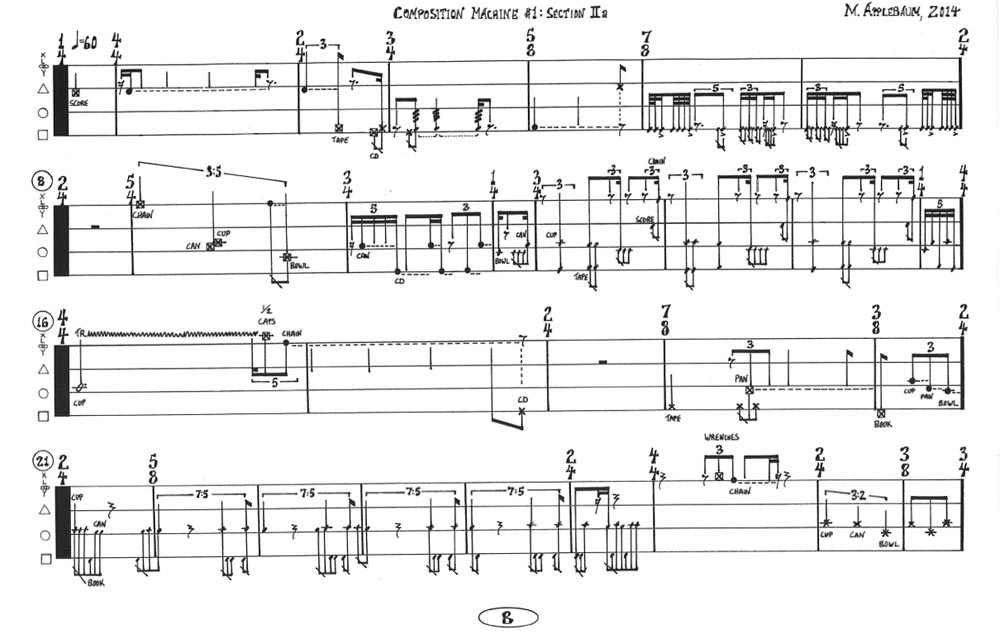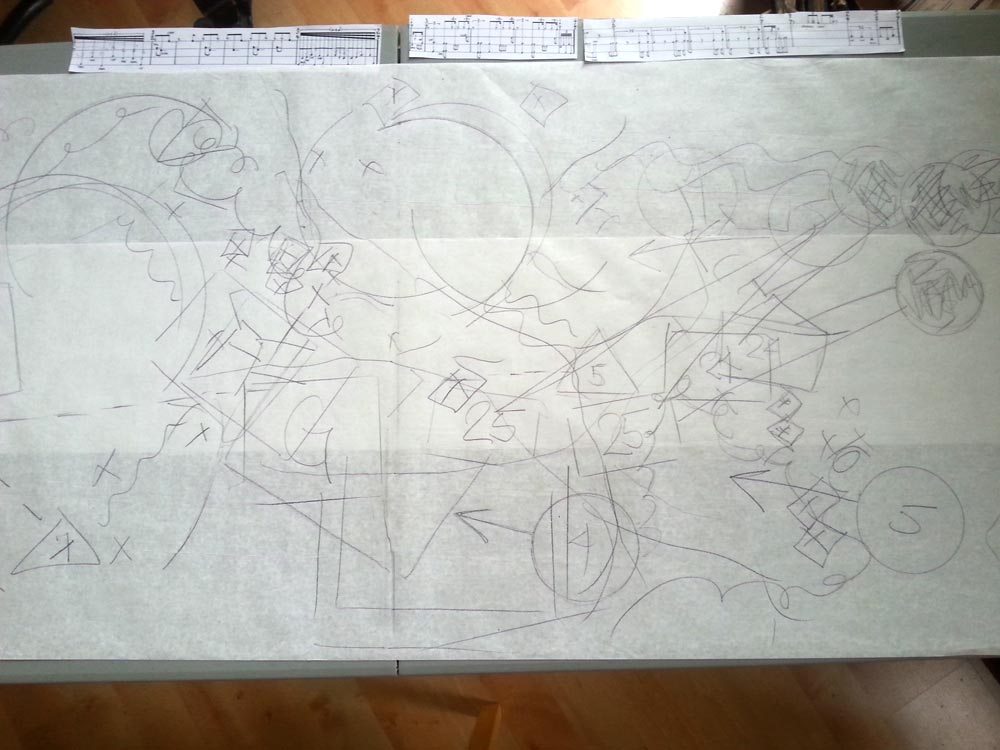Composition Machine #1 (2014)

Soloist playing pictographic notations, amplified table, various objects, and marker. For Terry Longshore. Co-commissioned by sixty-one players.
A synopsis of the piece will help explain its unusual concept. The performance begins at stage right where the performer unfurls a scroll of pictographic notation and plays it according to a personal but predetermined interpretation system. The scroll is then ingloriously compacted and dropped onto an amplified table covered in paper at center stage. A miscellaneous bevy of prescribed objects is placed on the table and moved in given rhythmic fashion. At the conclusion of this ritual the outlines of the objects are traced on the paper in marker. This paper—a new scroll—is then taken to a stage left position where it is performed on different instruments but according to the same fastidious interpretation system. The piece concludes after the player has rolled up the scroll and deposited it at the original stage right position, conceptually preparing for a subsequent performance. This is a piece that produces its own score; as such, the performer will notice that rehearsals should commence with the objects on the table in order to produce a germinal scroll.
Led by Terry Longshore, 61 players co-commissioned Composition Machine #1. There have been many performances (some which may be seen on YouTube). A particularly effective presentation was made by SPEAK Percussion in Melbourne at the Australian National Academy of Music. Part of SPEAK’s Emerging Artist Program, seven percussionists prepared individual renderings of the piece and presented them simultaneously in seven different performance spaces (e.g., large concert halls, an industrial kitchen, practice rooms for an audience of three); the concert event had four performance “rounds,” the audience members receiving randomized packets of four colored tickets at the outset that sent them to different spaces during the evening.

Each performance demonstrates the odd partnership of composer and performer, and the strange dilemma that surrounds the performer as composer. The following mini-essay, A Welcome Problem, appears in the forward to the score:
Do you want to sound like you? I mean, isn’t that a bit boring? You can sound like you anytime you compose your own music or improvise something. Shouldn’t this piece function as an occasion, as a stimulus for you to sound different? If your response to the pictographs sounds like you, what is the point of the enterprise? And moreover, if you sound like you, then maybe you are the composer. People will think that you are doing all the “heavy lifting” (even if in reality it might take less “effort” for you to sound like you). Then a crisis of authorship will arise and you’ll resent me.
But why sound like me? That seems worse. If you sound like me then everyone who plays this piece will sound like me. And that makes one piece, whereas I want this provocation—this impetus—to sound like many pieces. And besides, I’m bored of me; I need less me in my life, not more. I could stand a little bit of you. (Or a lot of you.)
So let’s have you. The whole point is to hear more of you.
But we’ve already established that there is something underachieving about using this piece to sound like you. So now what?
What are we going to do?
Dear performer—intrepid partner—I offer you this modest irritant disguised as a piece of music. But it is not a piece of music. It is a composition machine. And the composition it makes is not a sound world. (Those vibrations are merely evidence that you’ve activated the machine.) The contraption is an invitation to interact with the very question of invention and interpretation. And your resulting aural vibrations and visual frequencies are the sonic and ocular detritus of an inquiry, proof that we were here asking not the eternally hackneyed question “why are we here?” but the more consequential “so what are we going to do?” Experimental | Why Experimental?
Experimental | Why Experimental?
Various performances have started to emerge on YouTube. But, by nature, there is not a singular representative realization.